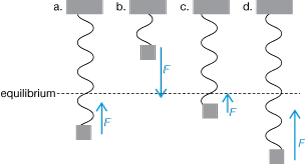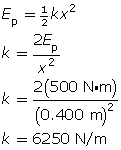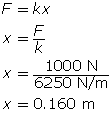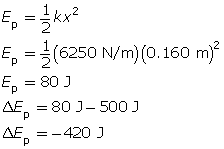Module 6—Work and Energy
Elastic Potential Energy
Hooke's law: the amount of stretch (deformation) of an elastic object is proportional to the force applied to deform it
Expressed as an equation, it is
F = kx
When a person attached to a bungee cord jumps from the top of a crane, he or she immediately reduces his or her height and, hence, the amount of gravitational potential energy. Where does the energy go? Obviously, the potential energy becomes kinetic (motion) energy. But in what form is the energy when the person comes to a complete stop before impacting the ground?
A bungee cord is a giant spring, and it holds the energy as elastic potential energy. In principle, a bungee jumper is identical to a spring with a weight hanging from it—which exhibits simple harmonic motion. This means that the spring is vibrating with a constant frequency or period of motion and that there is a restoring force directed towards the central equilibrium point. Furthermore, the magnitude of the restoring force is proportional to the displacement from the equilibrium point. This is known as Hooke's law.

| Quantity | Symbol | SI Unit |
| force (magnitude of applied force) | F | N |
| force constant of the spring (often called elastic constant or spring constant) | k | N/m |
| amount of stretch (deformation) of the spring | x | m |

Graphing the force required to compress a spring versus the length of the spring gives a slope that is equal to the spring constant.
In Newtonian mechanics, W = Fd; but in the case of a spring, the force is not constant. So, the graphical version of Hooke’s law is used to generate an expression for the elastic potential energy of a weighted spring. Taking the area of the force-position graph for a spring reveals that ![]()
Combining two equations will give an energy equation that can be used to solve problems in terms of the spring constant and the amount of stretch or deformation in the spring.

The force of gravity and the elastic force of an ideal spring are referred to as conservative forces. For a conservative force, work done against it is stored and is recoverable. If the work is done against gravity, as is the case with bungee jumping, this work is stored and transferred back to gravitational potential energy and kinetic energy as the jumper bounces back up.
It must be noted that friction is a non-conservative force. Work done against friction cannot be recovered. Work done against friction is converted into some other form of energy—mainly thermal energy. In the end, the bungee jumper stops bouncing as all the energy is eventually converted to heat by non-conservative forces, such as friction in the bungee cord and air friction.
 Read
Read
Read “Hooke’s Law” and “Elastic Potential Energy” on pages 299 to 302 in your textbook.
 Self-Check
Self-Check
SC 4. Solve question 5 of “Practice Problems” on page 301 of your textbook.
 Self-Check Answers
Self-Check Answers
SC 4.
(a)
Given
Ep = 500 J
x = 0.400 m
Required
the force to produce the stretch (F)
Analysis and Solution
Use the elastic potential energy formula to find k. Then use Hooke’s law to find the force.


Paraphrase
The force needed to produce the stretch is 2.50 × 103 N.
(b)
Given
F = 1000 N
x = 0.400 m
Required
the change in elastic potential energy (ΔEp)
Analysis and Solution
Use Hooke’s law to find the stretch, and insert that value into the elastic potential energy formula to find the new potential energy. Then subtract the original potential energy from the new value to get the change in potential energy.


Paraphrase
The change in elastic potential energy is −420 J.